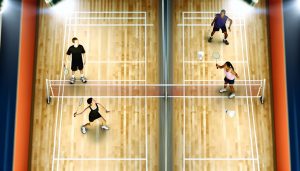When starting out with badminton, consider lightweight rackets for easier handling and maneuverability. Look for a head-light balance for better control and quick reactions, especially if you enjoy a defensive playstyle. Choose a comfortable grip size to prevent hand strain. Materials like aluminum or graphite help balance cost and performance well. Keep string tension lower for a larger sweet spot, aiding skill development. Setting a budget guarantees smart purchasing decisions. There's a lot more to discover to enhance your game!
Key Takeaways
- Select a lightweight racket for easier handling and reduced injury risk, ideal for beginners learning the game.
- Opt for a head-light balance for better maneuverability and defensive play in fast-paced games.
- Choose a grip size that fits comfortably in your hand to enhance control and reduce strain.
- Consider affordable materials like aluminum for durability or graphite for better power and control.
- Start with lower string tension to benefit from a larger sweet spot and ease of use.
Understanding Racket Weight Categories
When you're picking out your first badminton racket, understanding racket weight categories is key to finding the perfect fit for your game. You mightn't realize it, but the weight of your racket can greatly impact your playing style and comfort on the court.
Typically, rackets come in three main weight categories: lightweight (under 85 grams), medium-weight (85-90 grams), and heavyweight (over 90 grams).
As a beginner, you'll likely prefer a lighter racket. It's easier to handle, allowing you to swing faster and focus on developing your skills without tiring quickly. Plus, a lightweight racket helps you maneuver more easily, which is great when you're still getting the hang of the game. Additionally, lightweight rackets can reduce risk of arm and wrist injuries, making them a safer choice for those new to the sport.
On the other hand, if you feel you need more power in your shots, a medium-weight option might suit you better. Remember, the best racket weight is the one that feels right for you.
Exploring Balance Points and Their Impact
When choosing your first badminton racket, it's important to contemplate how the balance point can match your playing style.
A head-heavy racket can give you more power for smashing, while a head-light racket offers quicker maneuverability for defense.
Finding the right balance can make your game more enjoyable and effective.
Additionally, head-heavy rackets are favored by aggressive players for quick, powerful shots.
Head-Heavy vs. Head-Light
How does the balance of a badminton racket affect your game? Understanding this is key to choosing the right racket for you.
A head-heavy racket offers advantages like increased power in your smashes and deeper clears, helping you make a solid impact with the shuttle. It's perfect if you enjoy playing an aggressive game, delivering that extra oomph in your shots.
On the other hand, a head-light racket provides benefits of greater maneuverability and speed, letting you react quickly during rallies. This is ideal if you prefer a fast-paced, defensive style, allowing swift net play and quicker returns.
Both balance types have unique strengths, so think about what suits your playing style best to enhance your badminton experience.
Balance for Playing Style
Finding the right balance point in a badminton racket can make a world of difference in how you play. It's all about finding what suits your play style and balance preferences. Balance impacts how you control and maneuver the racket. Here's a handy guide to help you understand different balance points:
| Balance Type | Description | Ideal For |
|---|---|---|
| Head-Heavy | More mass towards the head | Power players |
| Even Balance | Balanced weight distribution | All-round players |
| Head-Light | More mass towards the handle | Defensive/control players |
If you love smashing and aggressive shots, a head-heavy racket might be your best friend. Prefer quick, precise moves? Consider a head-light option. For balanced play, an even balance could be perfect. Choose what feels right for you!
Selecting the Right Grip Size
Ever wondered why your hand strains while playing badminton? It could be due to the grip size of your racket. Selecting the right grip size enhances grip comfort and guarantees you enjoy your game without unnecessary fatigue.
Here's how you can choose the perfect grip:
- Measure Your Hand: Wrap a measuring tape around your palm. This helps you find a grip size that suits your hand for maximum comfort.
- Feel the Texture: Different grip textures offer varied sensations. Some are smooth, while others are tacky. Choose one that feels right for you.
- Test for Control: A suitable grip size allows you to control your shots better. If the racket twists in your hand, the grip might be too big.
- Consider Overgrips: If you're unsure, consider adding overgrips. They provide extra cushioning and adjustability for a more tailored fit.
- Experiment With Grip Types: Try out different badminton racket grip types like Towel Grip, PU Grips, and Rubber Grips to find which one complements your playing style and comfort preferences best.
Material Choices and Their Benefits
When you're picking your first badminton racket, understanding the materials can make all the difference in your game.
Lightweight options like graphite offer speed and agility, while some materials provide extra durability and strength.
Balancing cost with performance is key, so let's explore what suits your style and budget best.
For beginners, a racket with a lightweight design can enhance control and reduce strain, making it easier to ease into the sport without overexertion.
Lightweight Racket Materials
While exploring your options for a lightweight badminton racket, it's essential to understand the materials used and their benefits. Choosing the right material can enhance your game and comfort.
Here are some popular choices:
- Carbon Fiber: Known for its strength and lightness, carbon fiber offers excellent control and speed. It's a favorite among players seeking precision.
- Aluminum Alloy: This material is budget-friendly and great for beginners. It's a bit heavier than carbon fiber but provides durability and solid performance.
- Graphite Composite: Combining carbon fiber with other materials, graphite composites deliver a balance of flexibility and power, perfect for versatile play.
- Titanium Mesh: For those looking for something extra, titanium mesh adds stability and resilience, enhancing the racket's overall performance.
Choose what feels right and enjoy the game!
Durability and Strength Factors
Choosing a badminton racket with the right durability and strength can make a big difference in your playing experience. You want a racket that can handle intense matches without breaking a sweat. Durability testing guarantees that your choice stands up to the test of time, while strength ratings help you find a racket that matches your playing style. Different materials offer various benefits; here's a quick guide to help you decide:
| Material | Benefit |
|---|---|
| Aluminum | Lightweight, affordable |
| Graphite | Strong, flexible |
| Carbon Fiber | High strength, durable |
| Steel | Sturdy, budget-friendly |
| Titanium | Excellent shock absorption |
Cost vs. Performance
Finding the right balance between cost and performance is key when picking a badminton racket that suits both your budget and playing needs.
Conducting a cost analysis helps you understand what you're paying for regarding performance metrics. Different materials offer various benefits:
- Aluminum: Affordable and durable, great for beginners seeking value.
- Graphite: Offers excellent power and control, ideal for intermediate players looking to enhance skills.
- Carbon Fiber: Lightweight and strong, perfect for advanced players aiming for high performance.
- Titanium: Combines strength with lightweight properties, offering a blend of power and precision.
Choosing the right material depends on your playing style and how much you're willing to spend.
Evaluating String Tension for Beginners
When you're just starting out in badminton, understanding string tension can feel a bit overwhelming, but it's an essential aspect of finding the right racket.
As a beginner, you'll want to focus on string tension that complements your developing skills. Lower string tension, typically between 17-20 lbs, is often recommended for beginners. This range provides a larger sweet spot, offering more forgiveness on off-center hits, which is ideal as you're learning the game.
Beginner preferences usually lean towards rackets with lower tension because they're easier on the arm and help generate additional power with less effort. Approximately 12 meters of string is needed for effective badminton stringing, so ensure you have enough when setting up your racket.
It's important to remember that while higher string tension offers more control and precision, it requires better technique to fully benefit from it.
So, as you focus on improving your skills, start with a more forgiving tension and gradually adjust as you gain confidence and experience.
Trust your instincts and enjoy the learning process!
Setting a Budget and Making Smart Purchases
Setting a budget is one of the first steps in making a smart purchase for your first badminton racket.
It's important to evaluate how much you're willing to invest without breaking the bank. Smart shopping involves balancing quality and affordability.
Here are some budget considerations to keep in mind:
- Determine Your Maximum Spend: Decide on a top price you're comfortable with. This will help narrow down options and prevent overspending.
- Research Prices: Look at different brands and models within your budget range. Compare prices online and in-store to get the best deal.
- Look for Sales and Discounts: Keep an eye out for sales, clearance items, or discounts. You'd be surprised at the savings you can find with a little patience and timing.
- Evaluate Long-Term Value: Sometimes spending a bit more upfront can save money in the long run if the racket is durable and suits your playing style. Consider the racket specifications, such as weight, grip size, and shaft flexibility, to ensure the racket aligns with your playing needs.
Frequently Asked Questions
How Do I Determine My Playing Style Before Choosing a Racket?
Oh, so you're the next badminton prodigy? To find your style, observe your games: favor smashing shots for power play or prefer blocking and clearing for a defensive strategy. Embrace your unique approach; every player's different!
What Are the Best Brands for Beginner Badminton Rackets?
You're wondering about the best beginner racket brands. Yonex models are fantastic for control, Li Ning options offer great power, Victor selections provide balance, and Babolat choices mix style and performance. Each brand has something to offer newcomers.
How Often Should I Replace My Badminton Racket?
You should replace your badminton racket every 1-2 years, depending on usage. Regular play can cause performance degradation, reducing racket lifespan. Trust your instincts; if it doesn't feel right, it's time for an upgrade.
How Can I Check if a Racket Is Counterfeit?
To check if a racket's counterfeit, look for counterfeit signs like poor craftsmanship or misspelled branding. Verify brand authenticity by cross-referencing serial numbers on the manufacturer's website. You're not alone; many face this challenge, so double-check!
Are There Specific Rackets for Outdoor Badminton Play?
You'll find specific rackets for outdoor badminton. They're built with outdoor materials to withstand the elements. Focus on racket durability to guarantee a long-lasting, enjoyable experience. Don't worry; choosing the right one is easier than it seems!
Conclusion
Choosing your first badminton racket might seem like maneuvering through a labyrinth, but with the right knowledge, you'll find your way like Theseus with his string. Consider weight, balance, grip, material, and string tension like important clues on your journey. Remember, it's not just about the racket—it's about how it feels in your hands and complements your play. Set a budget, make smart choices, and soon enough, you'll be playing like a pro! Enjoy the game!








